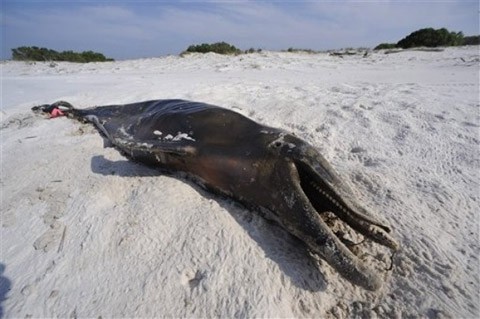And it's not stopping.
"The figure of 5,000 barrels a day was hastily produced by government scientists in Seattle. It appears to have been calculated using a method that is specifically not recommended for major oil spills.
Ian R. MacDonald, an oceanographer at Florida State University who is an expert in the analysis of oil slicks, said he had made his own rough calculations using satellite imagery. They suggested that the leak could 'easily be four or five times' the government estimate, he said.
'The government has a responsibility to get good numbers,' Dr. MacDonald said. 'If it’s beyond their technical capability, the whole world is ready to help them.'
Scientists said that the size of the spill was directly related to the amount of damage it would do in the ocean and onshore, and that calculating it accurately was important for that reason."
Scientists say they're not sure if it was oil that killed the dolphin pictured above, dead on Horn Island in the Gulf. But it sure as hell looks like it.
"Based on 'sophisticated scientific analysis of seafloor video made available Wednesday,' Steve Wereley, an associate professor at Purdue University, told NPR the actual spill rate of the BP oil disaster is about 3 million gallons a day — 15 times the official guess of BP and the federal government. Another scientific expert, Eugene Chiang, a professor of astrophysics at the University of California, Berkeley, calculated the rate of flow to be between 840,000 and four million gallons a day. These estimates mean that the Deepwater Horizon wreckage could have spilled about five times as much oil as the 12-million-gallon Exxon Valdez disaster, with relief only guaranteed by BP in three more months."




